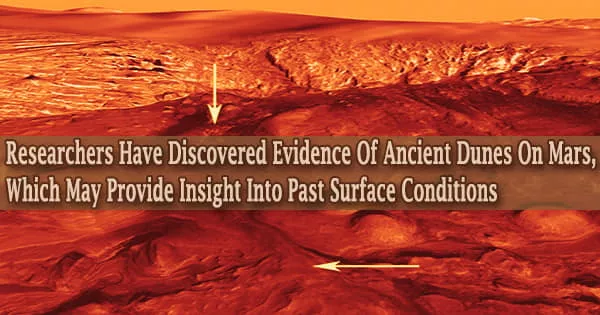Over the last 50 years, a significant driving force in Mars study has been determining whether Mars was previously capable of supporting life. Researchers use the rock record, a physical record of historical surface processes that reflect the environment and prevalent climate at the time the rocks were deposited, to deduce the planet’s ancient climate and habitability.
Researchers on the NASA-JPL Mars Science Laboratory mission utilized the Curiosity rover to investigate a unit of rocks within Gale crater to provide another piece to the jigsaw of Mars’ ancient history, according to a recent report published in JGR: Planets.
In Gale crater, they discovered evidence of an old dune field preserved as a layer of rocks that overlies rock layers deposited in a huge lake. The Stimson formation is named from the dune field’s rock remains.
The results aid scientists in their understanding of surface and atmospheric processes such as how the wind pushed sand to build dunes and how Mars’ climate changed from a potentially livable environment to an inhospitable one.
As the wind blows, it transports sand grains of a certain size, and organizes them into piles of sand we recognize as sand dunes. These landforms may be found in sandy deserts across the world, such as the Sahara, Namibian dune fields, and Arabian deserts. The shape and magnitude of the dune are controlled by the strength of the wind and its uniformity of direction, as evidenced by the rock record.
Dr. Steven Banham
The shape, migratory direction, and scale of the enormous dunes, also known as draas, that inhabited that area of the crater were rebuilt by looking at the preserved rock strata through photos acquired by the Curiosity rover.
Imperial researchers constructed models of ancient dunes that depict dunes snuggled next to Mount Sharp, the primary peak of Gale crater, on a wind-eroded surface at a five-degree angle. The study also discovered that the dunes were compound dunes, which meant that they were enormous dunes with their own set of tiny dunes that traveled in opposite directions to the main dune.
Lead author Dr. Steven Banham of Imperial’s Department of Earth Science and Engineering said: “As the wind blows, it transports sand grains of a certain size, and organizes them into piles of sand we recognize as sand dunes. These landforms may be found in sandy deserts across the world, such as the Sahara, Namibian dune fields, and Arabian deserts. The shape and magnitude of the dune are controlled by the strength of the wind and its uniformity of direction, as evidenced by the rock record.”
Dunes can rise and partially cover nearby dunes if there is an overabundance of material carried into a location. Cross-bedding is a characteristic seen in these buried strata that can reveal the scale of the dunes and the direction in which they were migrating. We were able to discover that these strata were produced by special dunes that arise when conflicting winds carry material in two separate directions by analyzing these cross beds.
“It’s amazing that from looking at Martian rocks we can determine that two competing winds drove these large dunes across the plains of Gale crater three and a half billion years ago. This is some of the first evidence we have of variable wind directions be they seasonal or otherwise.”
Mount Sharp’s lower slopes are made up of old lakebed deposits. When the crater flooded shortly after its construction 3.8 billion years ago, sediments piled on the lakebed. Curiosity has spent the last nine years looking for clues of habitability in these rocks.
Dr Banham added: “More than 3.5 billion years ago this lake dried out, and the lake bottom sediments were exhumed and eroded to form the mountain at the centre of the crater the present-day Mount Sharp. The flanks of the mountain are where we have found evidence that an ancient dune field formed after the lake, indicating an extremely arid climate.”
However, the new findings suggest that the ancient dune field might have been less nurturing of life than previously thought. Dr Banham said: “The vast expanse of the dune field wouldn’t have been a particularly hospitable place for microbes to live, and the record left behind would rarely preserve evidence of life, if there was any.”
“We know the dune field was preceded by lakes, but we don’t know what lies beneath the dry sandstones further up Mount Sharp. It’s possible that there are more layers formed in arid regions, or deposits linked with more humid climates. We will have to wait and see.”
Rovers on Mars are allowing researchers to explore the planet in detail like never before. Dr Banham added: “Although geologists have been reading rocks on Earth for 200 years, it’s only in the last decade or so that we’ve been able to read Martian rocks with the same level of detail as we do on Earth.”
The scientists are still looking at the rocks recovered by Curiosity, but they’re also concentrating on the wind patterns recorded by dunes higher up Mount Sharp. Dr Banham said: “We’re interested to see how the dunes reflect the wider climate of Mars, its changing seasons, and longer-term changes in wind direction. Ultimately, this all relates to the major driving question: to discover whether life ever arose on Mars.”
The research was financed by the UK Space Agency and is part of the ESA’s ExoMars mission, which will explore Mars in search of clues of ancient life.





